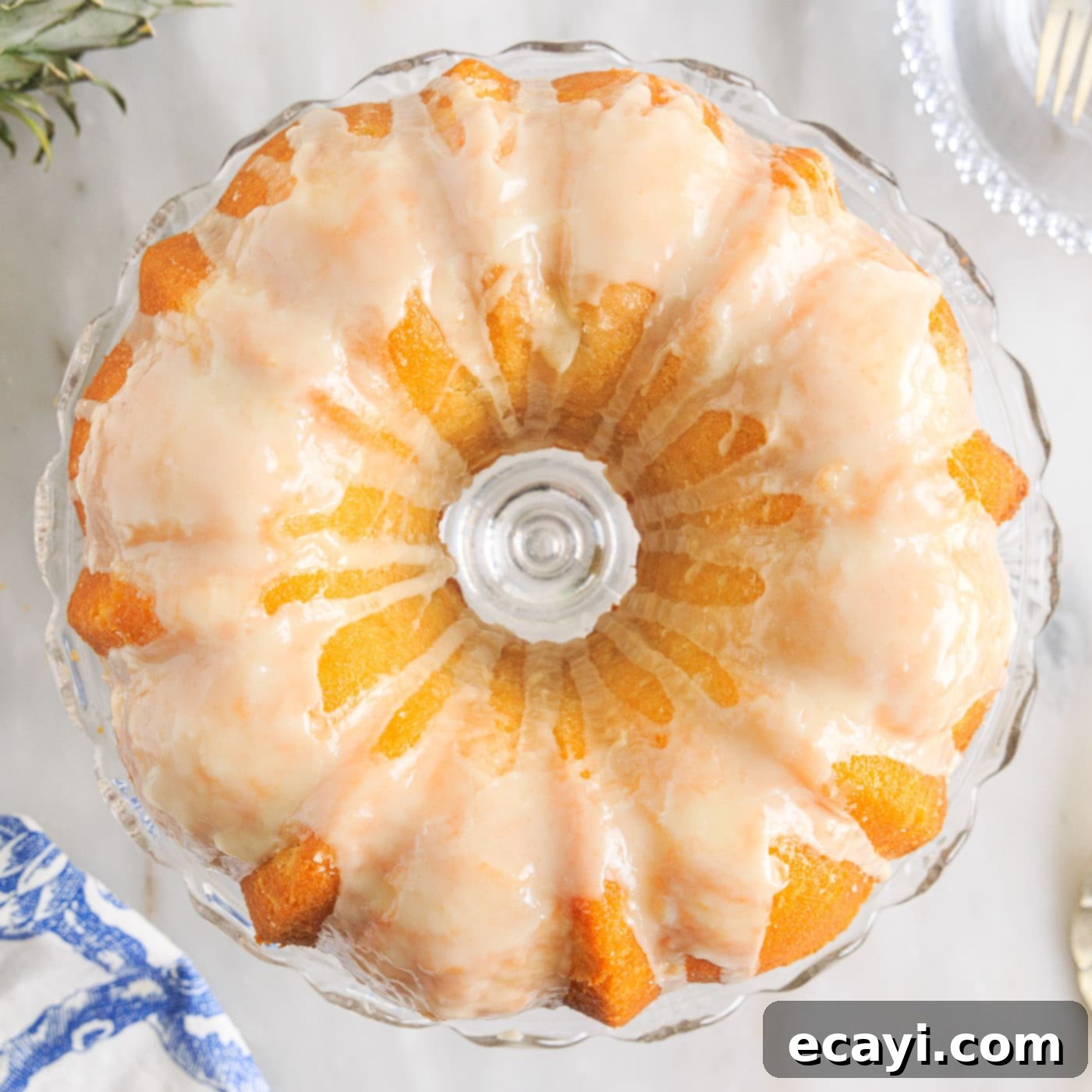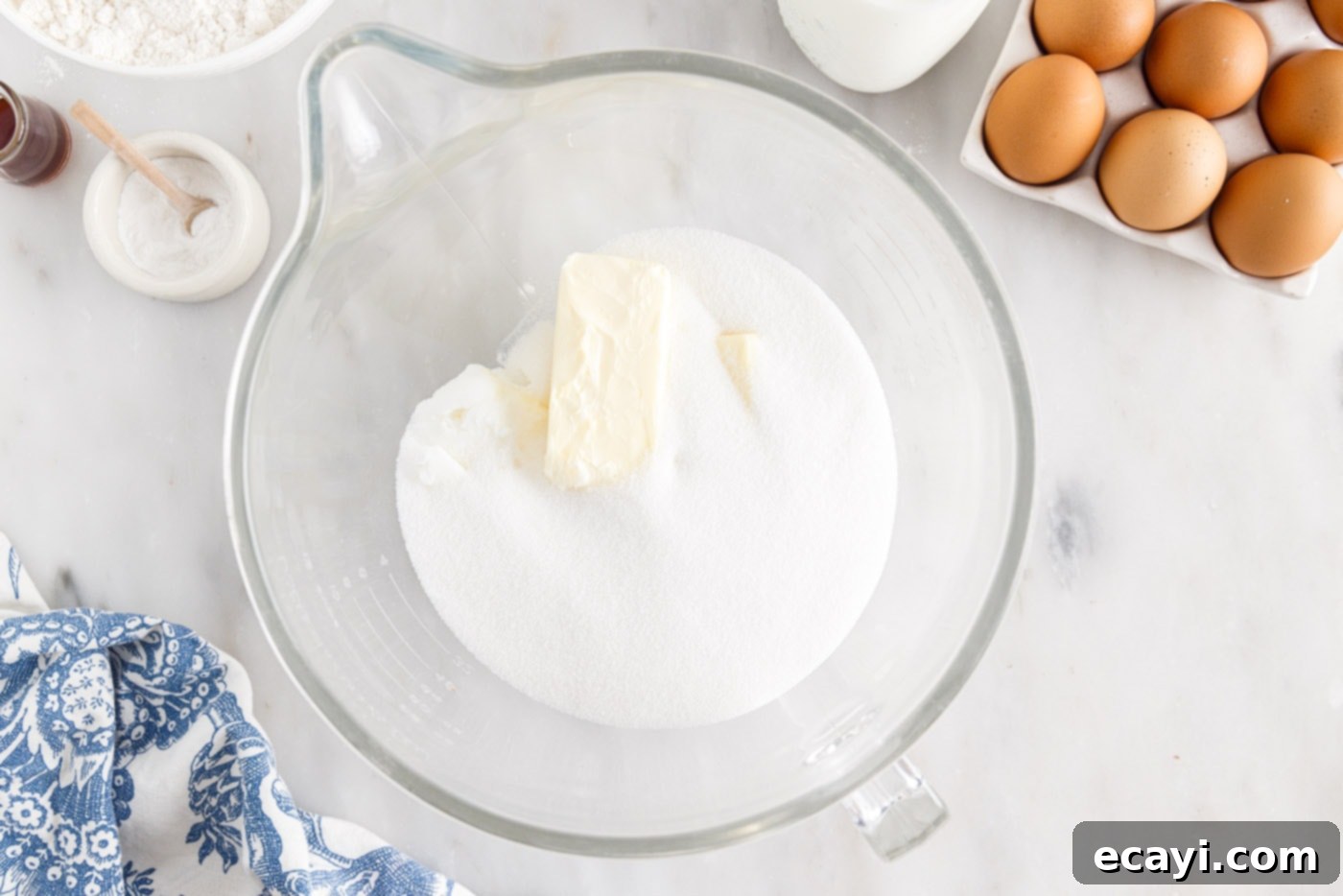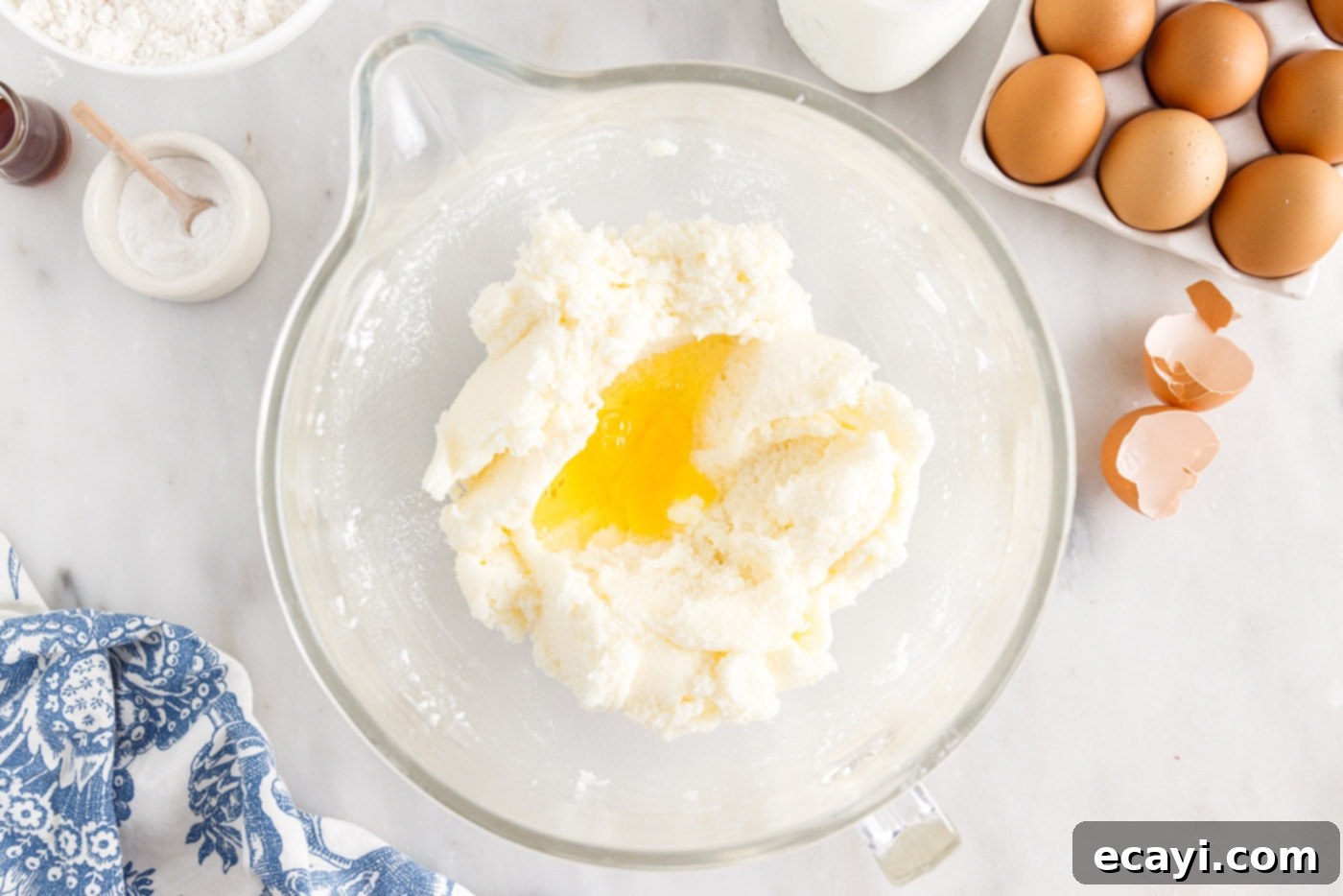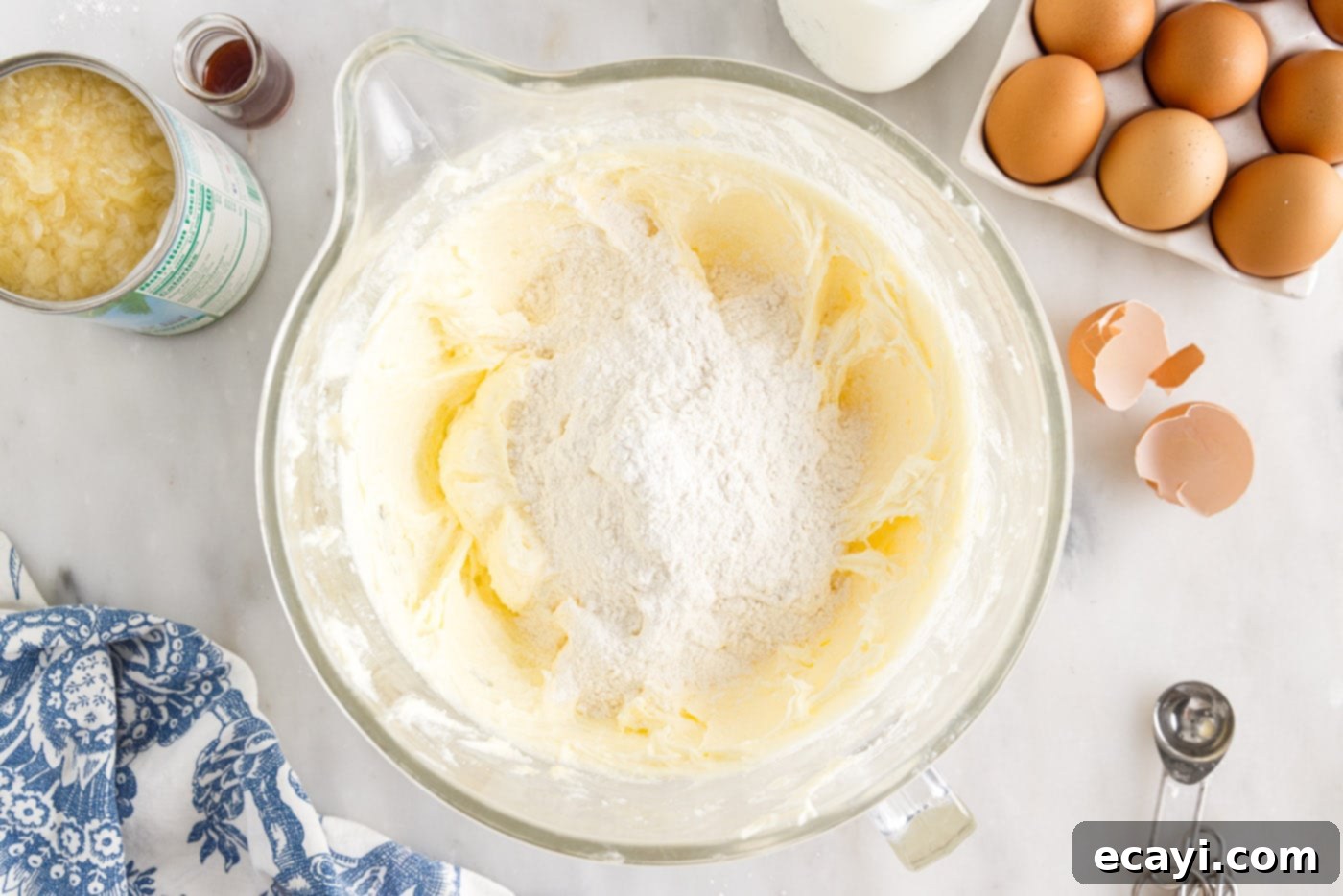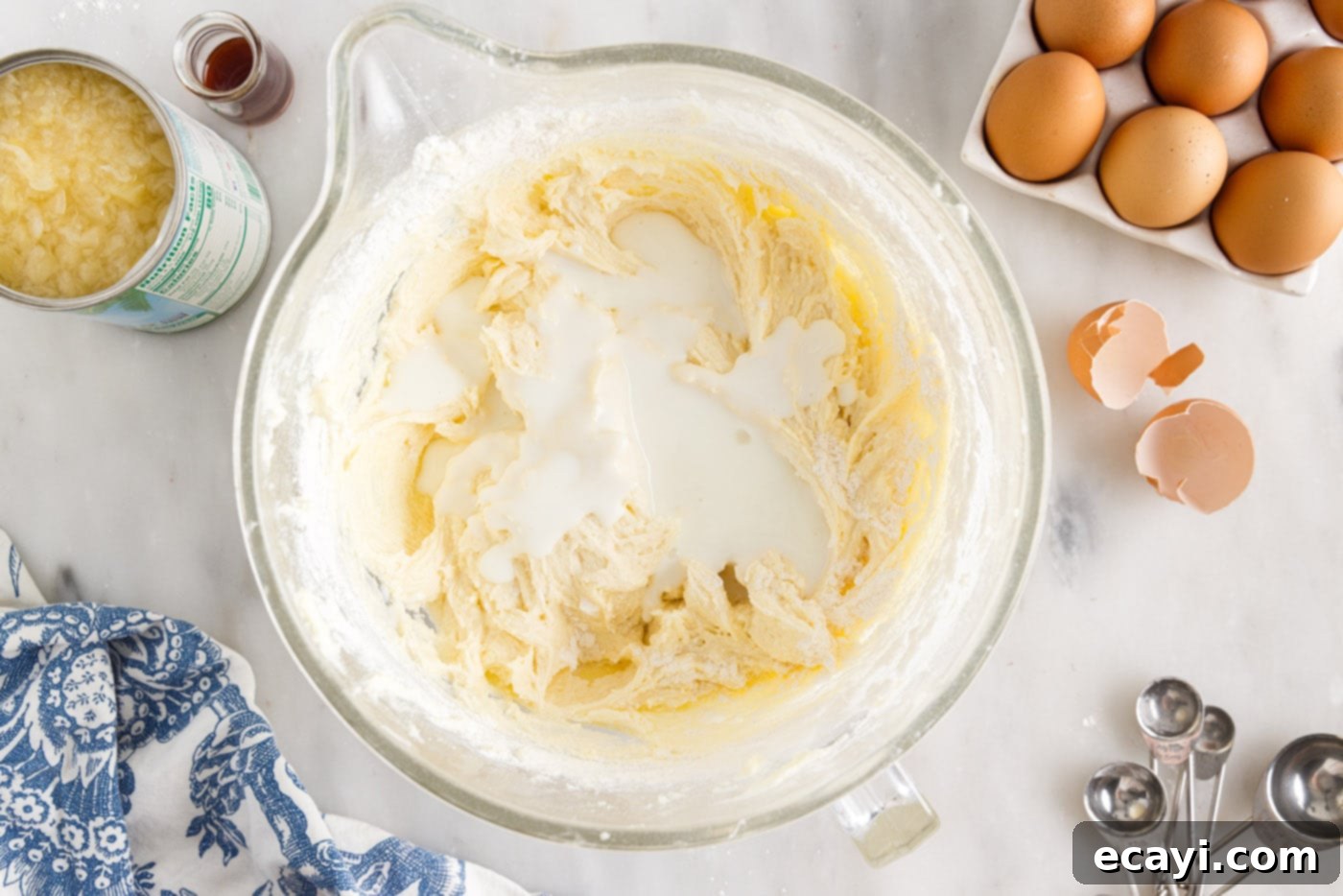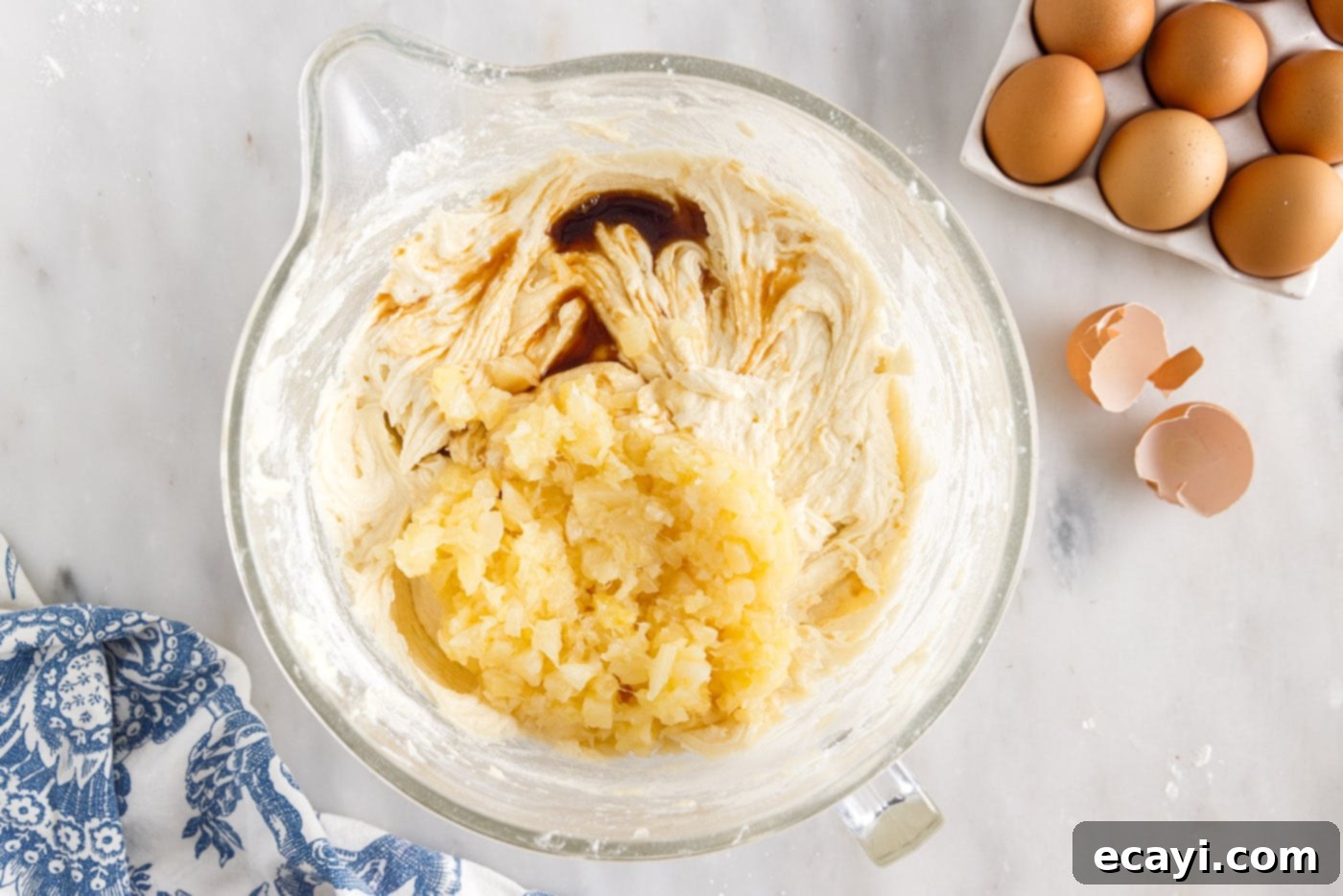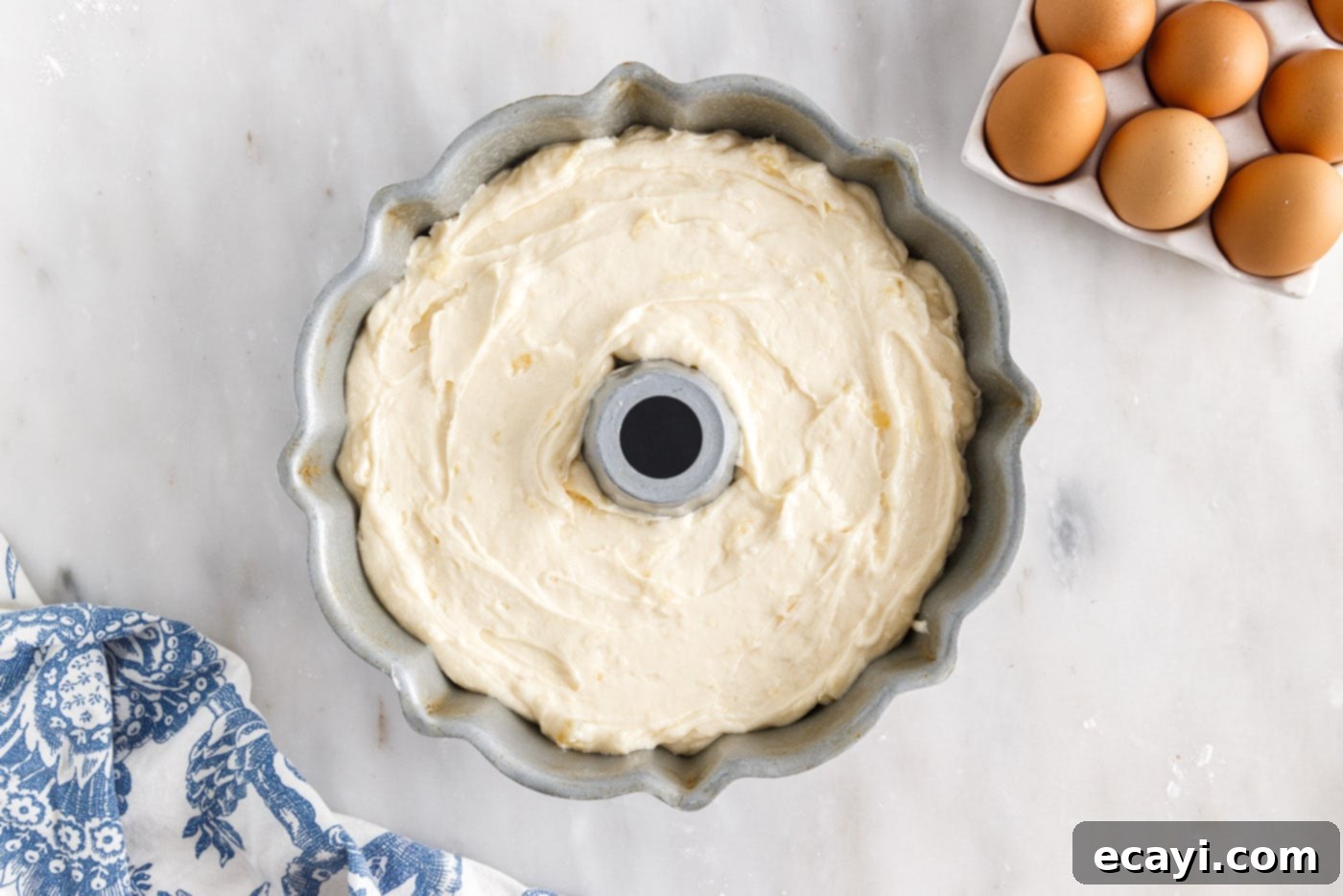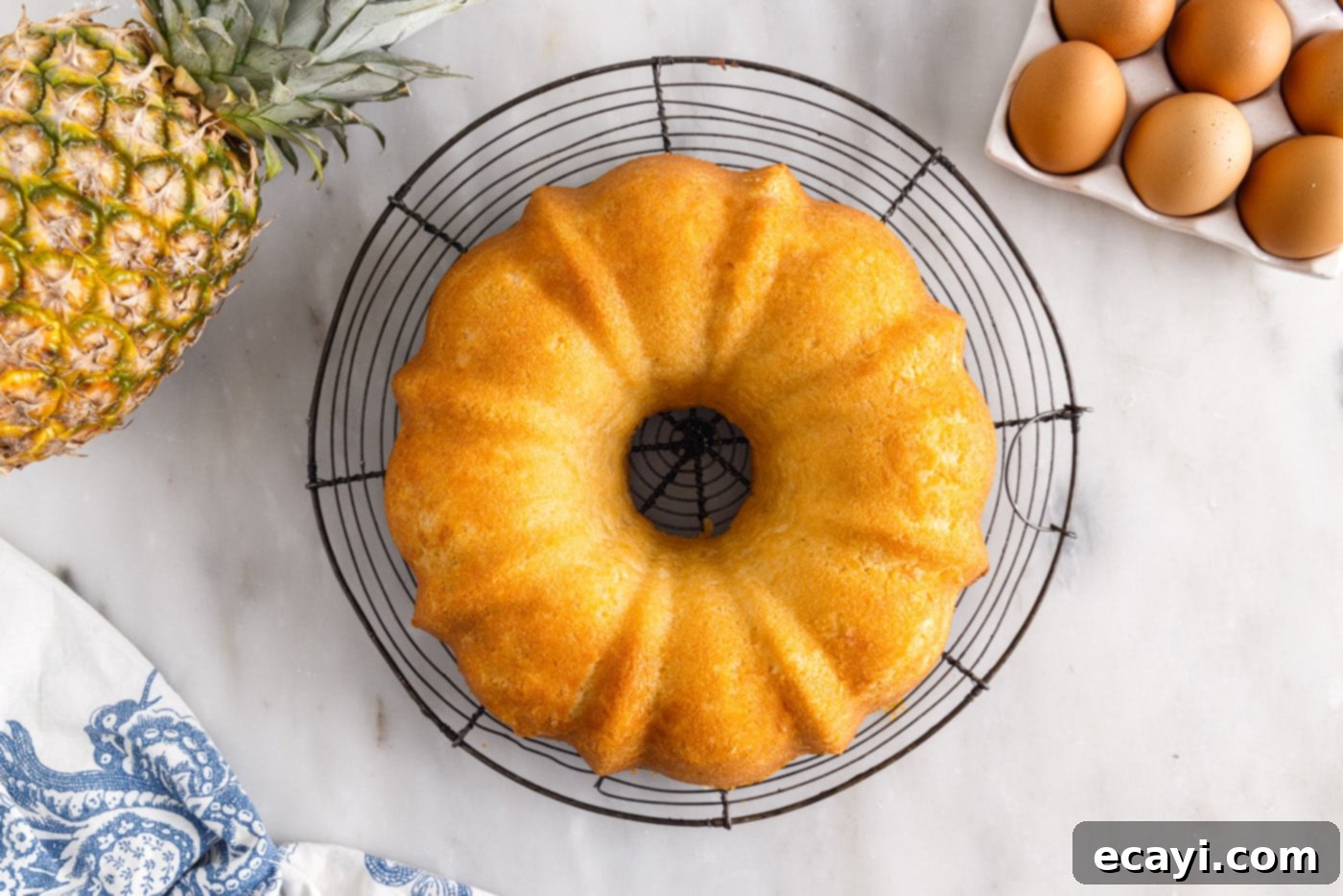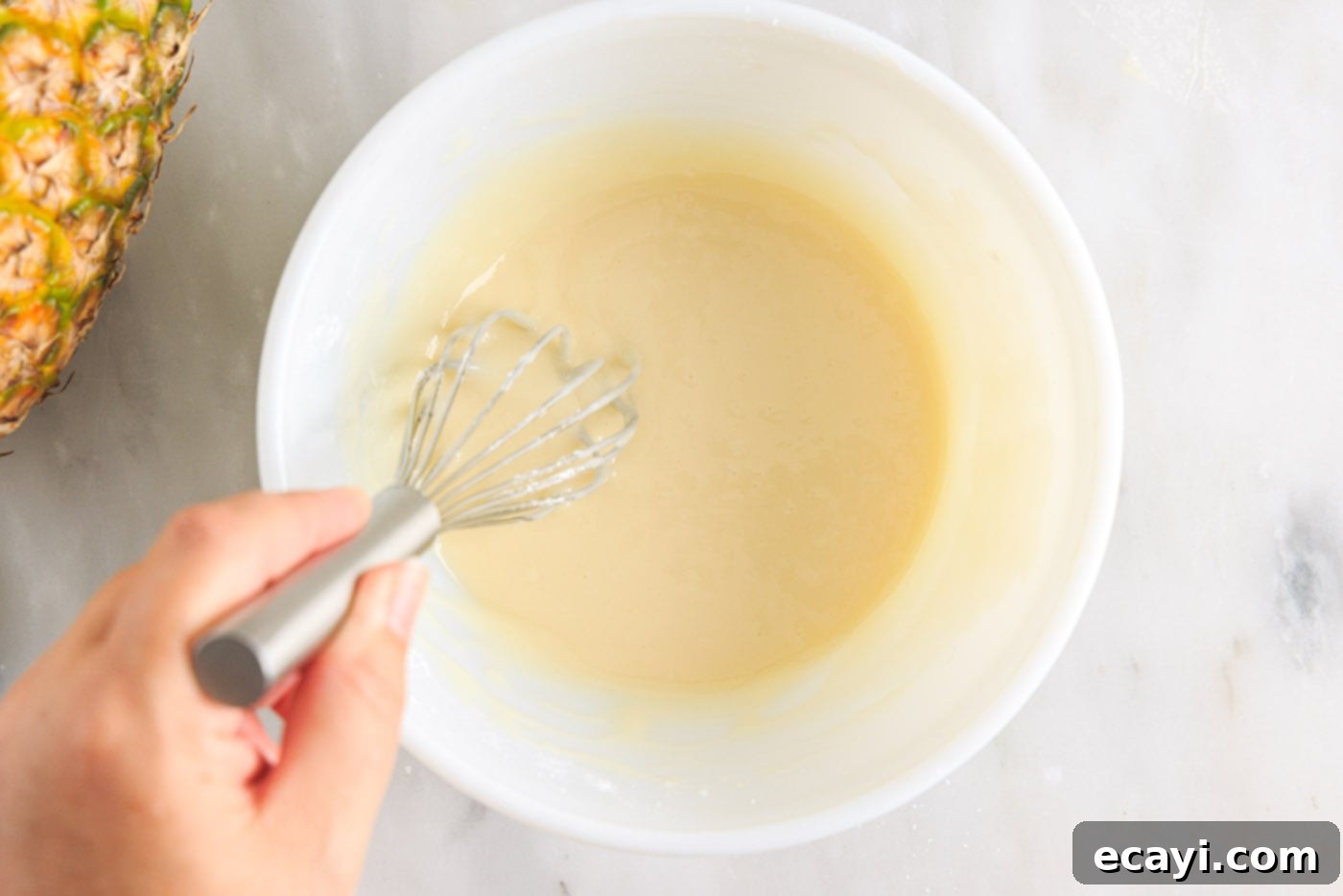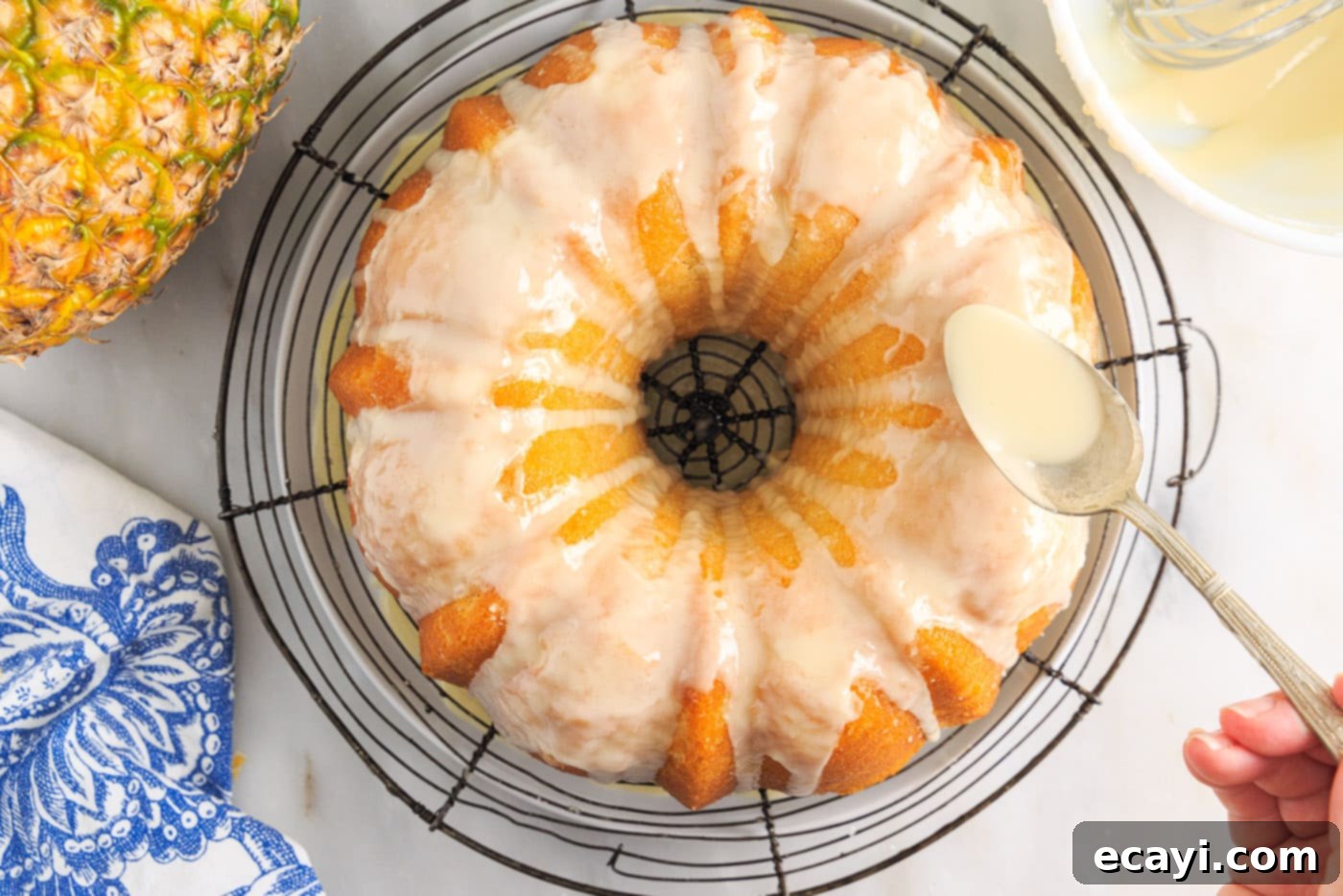Moist & Delicious Pineapple Pound Cake with Vanilla Glaze: Your Go-To Tropical Dessert
Indulge in the irresistible charm of a perfectly baked pineapple pound cake, a true celebration of tropical flavors and a rich, tender texture. This delightfully moist and dense cake, crowned with a sweet pineapple-vanilla glaze, is more than just a dessert – it’s a versatile treat perfect for any occasion. Whether you’re looking for a delightful breakfast companion, an afternoon snack, or an impressive dessert centerpiece, this supple pineapple cake with its exquisite crumb is sure to become a beloved favorite in your recipe collection.
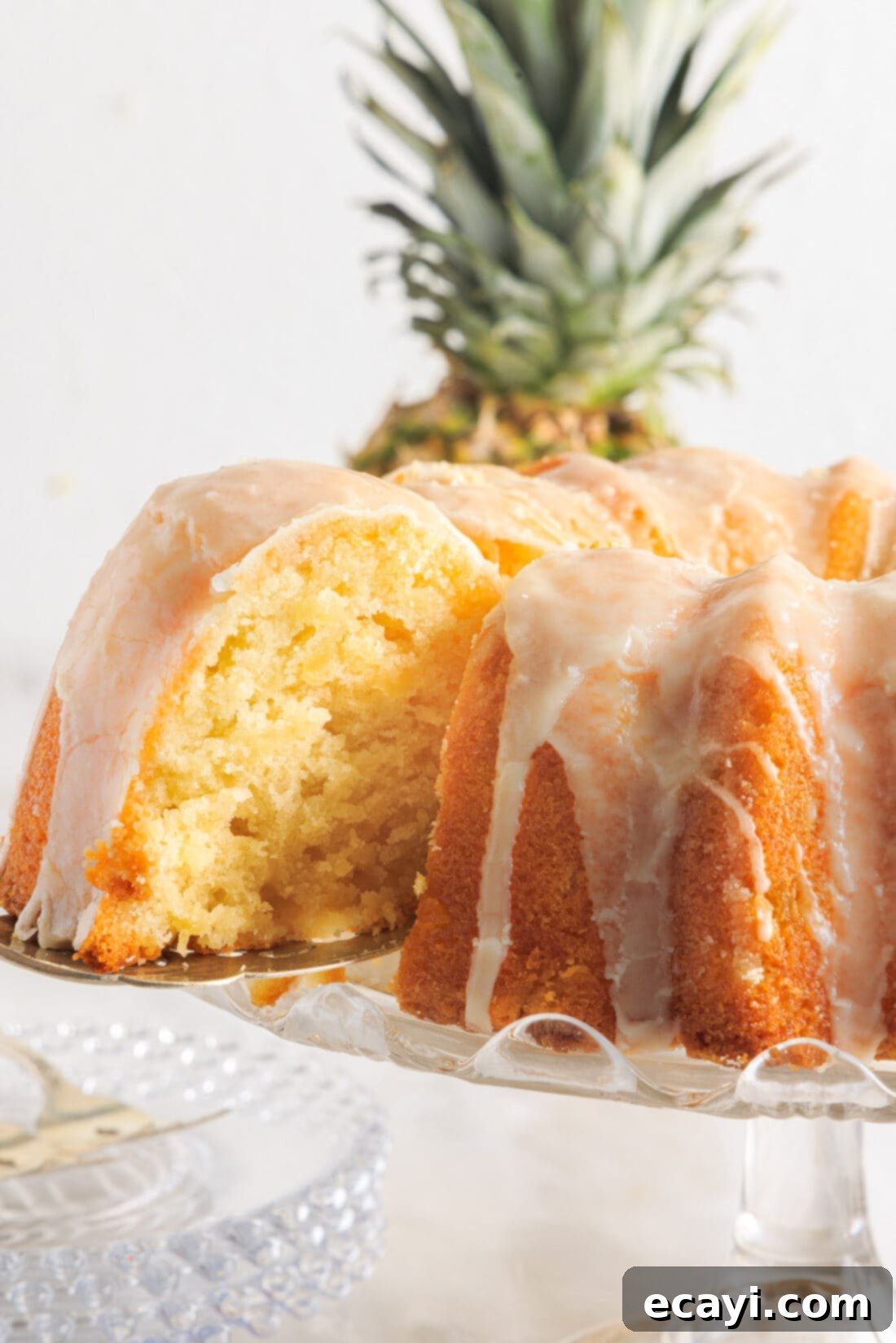
Why This Pineapple Pound Cake Recipe is a Must-Try
This isn’t just any pound cake; it’s a pineapple pound cake elevated to perfection. The recipe masterfully blends the classic richness and density of a traditional pound cake with a vibrant, sweet tropical flavor that truly shines through. What makes this recipe particularly special is its commitment to achieving that quintessential pound cake texture: dense yet incredibly moist, soft, and tender. Every bite promises a melt-in-your-mouth experience that’s satisfying without being heavy. The secret lies in a careful balance of ingredients and specific baking techniques that ensure optimal moisture and a fine crumb structure. To further enhance this tropical delight, a delicate pineapple-vanilla glaze is drizzled over the cooled cake, adding an extra layer of sweetness and a beautiful sheen that makes it as appealing to the eye as it is to the palate.
While many cakes can be baked in a bundt pan, this pineapple pound cake truly thrives in one, resulting in a stunning presentation that’s far more impressive than a simple loaf. The intricate design of the bundt pan cradles the rich batter, allowing it to bake evenly and emerge with an elegant shape that requires minimal decoration. It transforms a simple cake into a showstopper, making it ideal for entertaining or as a special treat for your family. Get ready to bake a pound cake that will have everyone asking for the recipe!
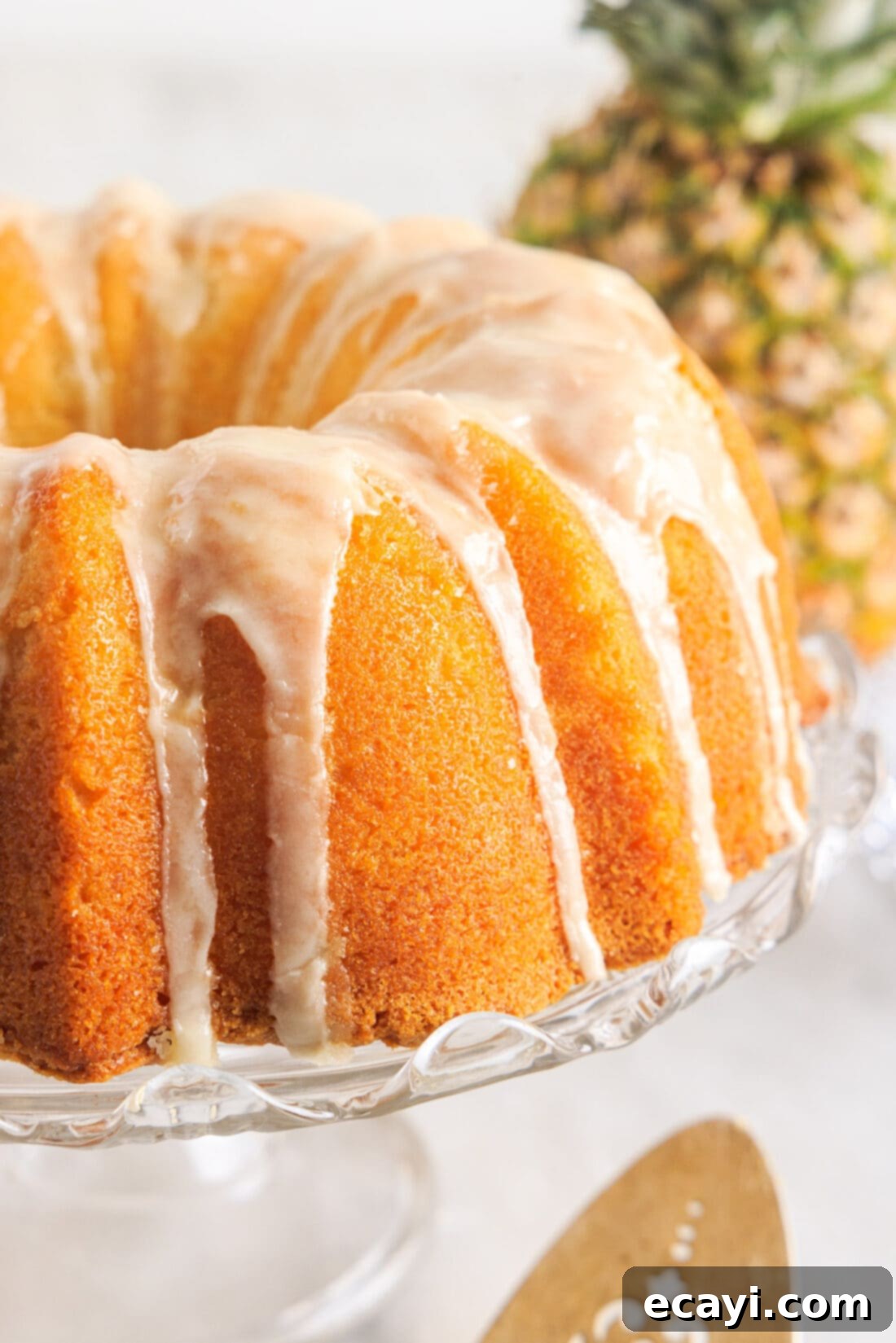
Essential Ingredients for Your Pineapple Pound Cake
Crafting this magnificent pineapple pound cake requires a selection of common baking ingredients, each playing a crucial role in achieving its signature flavor and texture. For a complete list of measurements, ingredients, and detailed instructions, refer to the printable recipe version available at the end of this post.
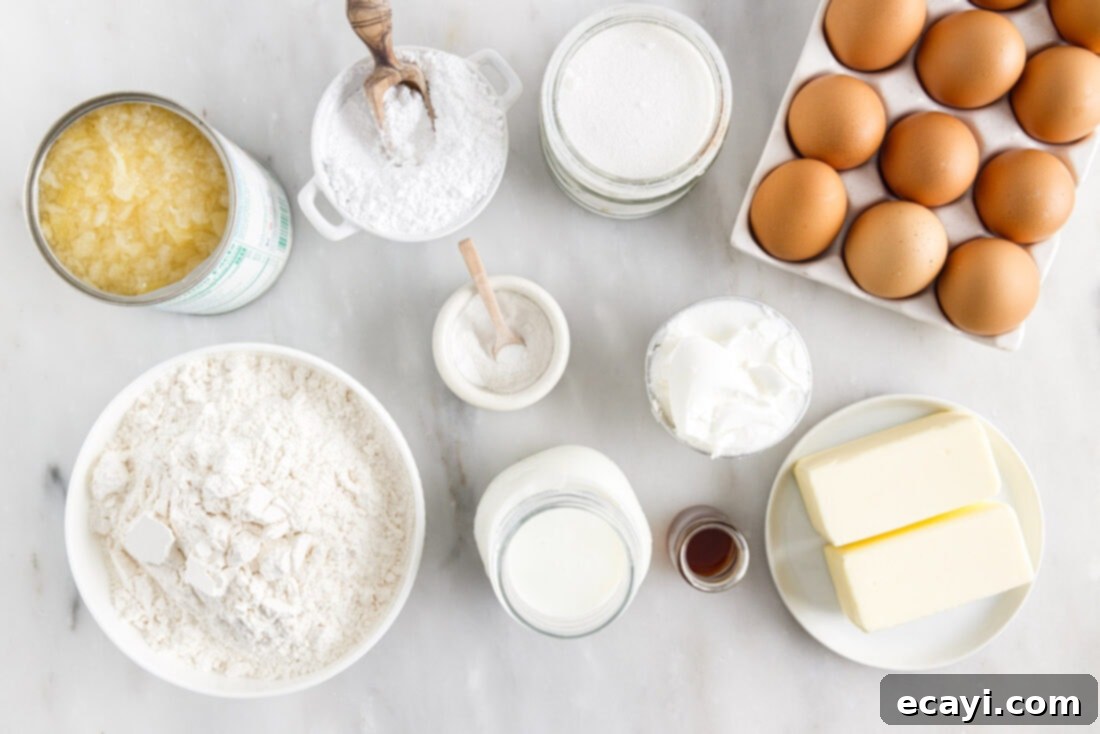
Ingredient Spotlight and Smart Substitution Suggestions
Understanding the role of each ingredient can significantly impact the success of your pound cake. Here’s a closer look at the key components:
PINEAPPLE – For this recipe, crushed pineapple is ideal as it distributes evenly throughout the batter, providing bursts of sweet, tangy flavor and extra moisture. It’s important to drain the crushed pineapple before adding it to the cake batter, but there’s no need for excessive squeezing or straining; a little residual juice is perfectly fine and contributes to the cake’s moistness. Crucially, remember to reserve this drained pineapple juice! It’s the secret ingredient for creating the sweet and tangy glaze that finishes the cake beautifully. Using fresh pineapple is possible, but ensure it’s very finely diced or grated and follow the same draining process to avoid an overly wet batter.
SHORTENING – The inclusion of shortening alongside butter is a key factor in achieving the pound cake’s signature fluffy yet dense texture and superior moistness. Shortening has a higher melting point than butter, which means it doesn’t melt as quickly during baking. This allows it to create more air pockets in the batter, resulting in a cake that’s both tender and has a finer crumb. If you prefer to bake with only butter, you can substitute a third stick (about 5 tablespoons) of unsalted butter for the shortening. However, be aware that this might slightly alter the texture, potentially making the cake a bit less airy but still delicious.
EGGS – Eggs serve multiple vital functions in a pound cake: they provide structure, moisture, and help with leavening. For the best results, ensure your eggs are at room temperature. Room temperature eggs emulsify more easily with fats and sugar, creating a smoother batter and incorporating more air when beaten. This increased volume translates into a lighter, more airy texture in your finished bundt cake. Beat them well after each addition, but be careful not to overbeat, as this can sometimes lead to a crumbly texture.
BUTTERMILK – Buttermilk is a superstar ingredient for moist and tender cakes. Its acidity reacts with the baking powder, providing an extra lift, and it also helps break down gluten, resulting in a wonderfully tender crumb. If you don’t have buttermilk on hand, you can easily make a substitute: simply add 1 tablespoon of white vinegar or lemon juice to a measuring cup, then fill the rest of the cup with regular milk until it reaches ½ cup. Let it sit for 5-10 minutes until it slightly curdles. Just like eggs, make sure your buttermilk is at room temperature for optimal batter consistency.
FLOUR & SUGAR – Accurate measurement of these staples is critical. For flour, always use the “scoop and sweep” method: lightly spoon flour into your measuring cup until it overflows, then level it off with a straight edge. Packing flour can add too much to the recipe, leading to a dry, dense, and crumbly cake. Granulated sugar not only sweetens but also aids in moisture retention and contributes to the golden crust. Ensure both are high quality for the best flavor.
How to Make Pineapple Pound Cake: A Detailed Guide
These step-by-step photos and detailed instructions are provided to help you visualize each stage of making this delectable pineapple pound cake. For a concise, printable version of this recipe, complete with exact measurements and instructions, you can Jump to Recipe at the bottom of this post.
- Preheat your oven to 325°F (160°C). This lower temperature is ideal for pound cakes, allowing them to bake through evenly without drying out. Prepare a 9-inch bundt cake pan by spraying it thoroughly with a nonstick baking spray that contains flour. This ensures easy release of your beautiful cake. If you don’t have spray with flour, you can grease the pan generously with butter or shortening, then dust it lightly with all-purpose flour, tapping out any excess. Set the prepared pan aside.
- In a medium-sized mixing bowl, combine the all-purpose flour and baking powder. Whisk them together briefly to ensure the leavening agent is evenly distributed. This prevents lumps and helps the cake rise uniformly. Set this dry mixture aside.
- In the bowl of a standing mixer fitted with a paddle attachment, or using a large mixing bowl with a hand mixer, cream together the softened unsalted butter, shortening, and granulated sugar. Beat on medium-high speed for 5-7 minutes, or until the mixture is light in color and fluffy. This creaming process incorporates air, which is crucial for the pound cake’s texture.

- Add the room temperature eggs one at a time to the creamed mixture, beating on high speed for about 30 seconds after each addition. Scrape down the sides of the bowl as needed to ensure everything is well combined. Beating the eggs in gradually allows for better emulsification and prevents the batter from curdling, contributing to a smooth and consistent texture.

- With the mixer on low speed, begin to alternate adding the flour mixture and the room temperature buttermilk to the wet ingredients. Start and end with the flour mixture. Mix only until just combined after each addition, being careful not to overmix. Overmixing can develop the gluten in the flour too much, leading to a tough cake.


- Finally, add the drained crushed pineapple and vanilla extract to the batter. Beat on low speed just until the pineapple is evenly distributed throughout the mixture. Again, avoid overmixing at this stage to maintain the cake’s tender crumb.

- Pour the prepared batter evenly into the greased and floured bundt pan. Bake for 75-85 minutes. Because this cake is dense and moist, it requires ample baking time. To check for doneness, insert a toothpick into the center of the cake. It should come out with only a few moist crumbs attached, but no wet batter. If it comes out clean, it might be slightly overbaked. Cool the cake in the bundt pan for exactly 30 minutes before inverting it onto a wire rack to cool completely. Cooling too quickly or too slowly can affect its integrity.


- While the cake is cooling, prepare the glaze. In a medium bowl, whisk together the melted unsalted butter, powdered sugar, vanilla extract, and the reserved pineapple juice until completely smooth and free of lumps. The consistency should be pourable but thick enough to cling to the cake. Once the cake is entirely cool, drizzle the glaze generously over the top. Allow the glaze to set slightly before slicing and serving.


Frequently Asked Questions & Expert Baking Tips
To maintain its freshness and moisture, store your pineapple pound cake in an airtight container. It will keep beautifully on the countertop for 3-4 days. If you wish to extend its shelf life, store it in the refrigerator for up to 7 days. Be sure it’s completely cooled before storing to prevent condensation.
Absolutely! This pound cake freezes exceptionally well for up to 3 months. If you plan to freeze the cake, it’s best to do so before adding the glaze. Reserve the glaze preparation for when you are ready to serve. Once the cake has cooled completely, wrap it tightly in plastic wrap or Press N Seal, followed by a layer of aluminum foil to prevent freezer burn. For added protection, place the wrapped cake in a large airtight container or an extra-large zip-top bag before freezing. To thaw, simply unwrap the cake and let it sit at room temperature for several hours, or transfer it to the refrigerator overnight.
This is a common issue! The most important step for easy release is proper pan preparation. Ensure you use a high-quality nonstick bundt pan. For this recipe, we recommend a nonstick baking spray with flour. Alternatively, you can grease the pan thoroughly with softened butter or shortening, ensuring every crevice is covered, then dust it evenly with flour, tapping out any excess. Make sure the cake cools in the pan for the recommended 30 minutes – too short, and it might fall apart; too long, and it can become stuck.
Yes, this pineapple pound cake is wonderfully adaptable! You can enhance the tropical theme by adding 1/2 cup of shredded coconut to the batter. A pinch of nutmeg or cardamom could also complement the pineapple beautifully. For an extra crunch, consider folding in 1/2 cup of finely chopped pecans or macadamia nuts with the pineapple. Always remember to adjust your liquids slightly if adding very wet ingredients, but nuts or dry additions usually won’t require changes.
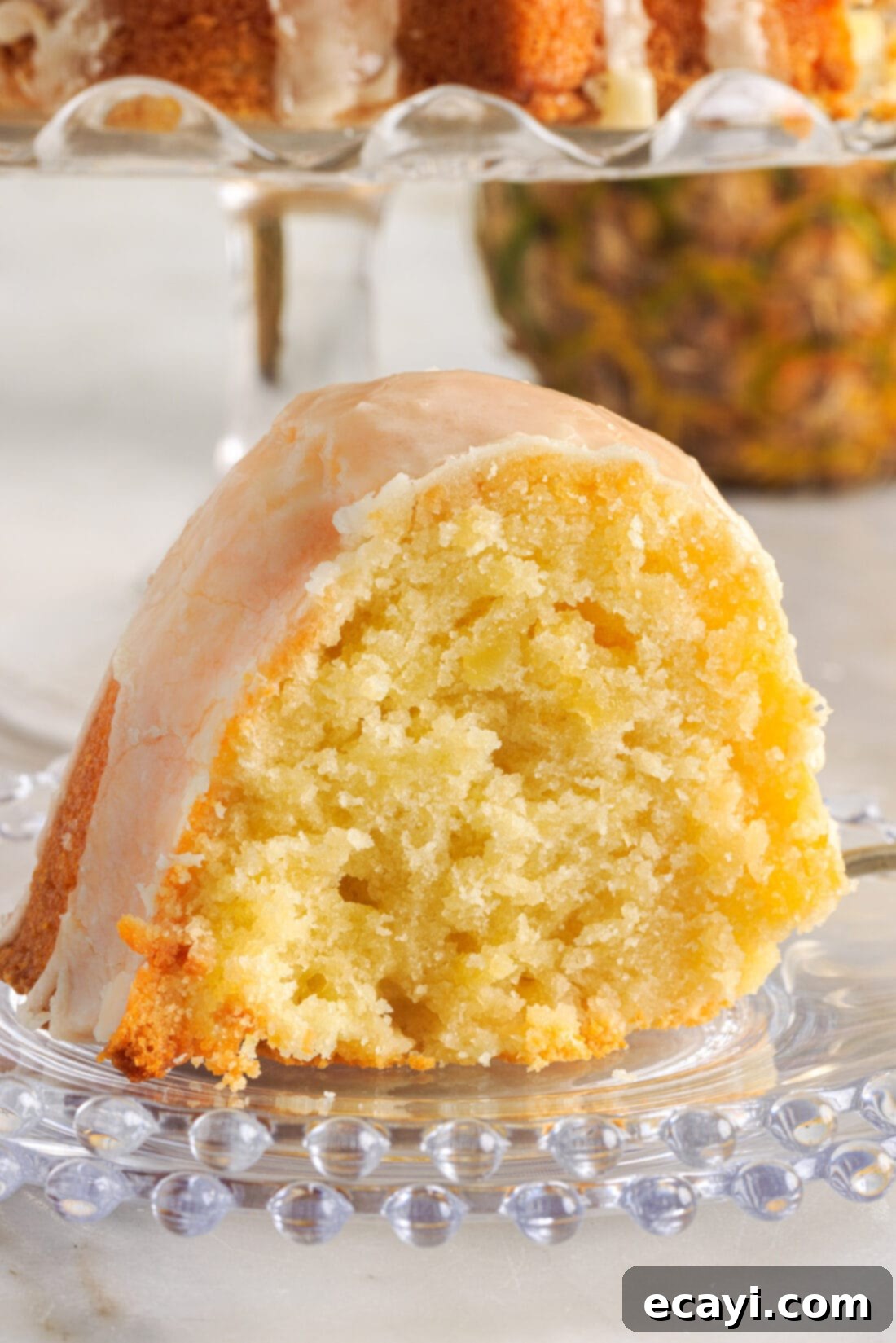
Perfect Serving Suggestions for Pineapple Pound Cake
While this pineapple pound cake is absolutely divine on its own, especially with its signature pineapple-vanilla glaze, there are many ways to enjoy and enhance this delightful treat. The glaze adds just the right amount of sticky sweetness and a beautiful sheen, but if you prefer a less sweet option, the cake is equally delicious served plain. Slice it at room temperature for optimal flavor and texture. It pairs wonderfully with a hot cup of coffee, a soothing herbal tea, or even a glass of iced tea, making it perfect for breakfast or an afternoon pick-me-up. For a more decadent dessert, consider serving a slice with a scoop of vanilla bean ice cream, a dollop of freshly whipped cream, or a sprinkle of toasted coconut flakes. A light drizzle of warm caramel sauce could also add another layer of indulgence. Enjoy this versatile cake however your heart desires!
More Delicious Quick Bread & Pound Cake Recipes
If you loved this pineapple pound cake, you’ll surely enjoy exploring more of our quick bread and pound cake recipes. They are perfect for sharing with family and friends or simply treating yourself!
- Classic Banana Nut Bread
- Delightful Blueberry Bundt Cake
- Charming Pound Cake Cupcakes
- Rich Whipping Cream Pound Cake
- Zesty Orange Poppyseed Pound Cake
- Sweet Strawberry Pound Cake
I’m passionate about baking and cooking, and I love sharing my culinary adventures and tested recipes with all of you! To make sure you never miss a new delicious creation, I offer a convenient newsletter with every new recipe post. Simply subscribe here and start receiving your free daily recipes directly to your inbox!
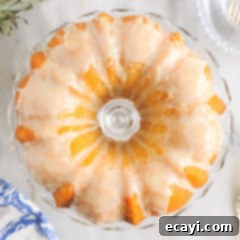
Pineapple Pound Cake
IMPORTANT – There are often Frequently Asked Questions within the blog post that you may find helpful. Simply scroll back up to read them!
Print It
Pin It
Rate It
Save ItSaved!
Ingredients
Cake
- 3 cups all-purpose flour
- 1 teaspoon baking powder
- 1 cup unsalted butter softened
- ½ cup shortening
- 2 ¾ cups granulated sugar
- 4 eggs at room temperature*
- ½ cup buttermilk at room temperature*
- 1 cup crushed pineapple 1 – 8 ounce can drained, juices reserved
- 1 teaspoon vanilla extract
Glaze
- 2 Tablespoons unsalted butter melted
- 2 cups powdered sugar
- ½ teaspoon vanilla extract
- ¼ cup reserved pineapple juice
Things You’ll Need
-
Stand mixer or hand mixer
-
Mixing bowls
-
9 inch bundt pan
-
Whisk
-
Wire cooling rack
Chef’s Notes & Pro Tips
- Ensure your flour is measured accurately using the “scoop and sweep” method. Never pack flour into your measuring cup, as too much flour can result in a dry, crumbly cake.
- The incredible moisture in this pound cake comes from both the buttermilk and the crushed pineapple. Make sure to drain the crushed pineapple before adding it to the batter, but don’t over-strain; a little juice clinging to the fruit is beneficial.
- This cake is notably dense and moist, so it requires a longer baking time, typically at least 75 minutes. Always test the center with a toothpick to confirm doneness – it should come out with a few moist crumbs, not wet batter.
- Shortening contributes to a fluffier and moister cake texture due to its higher melting point compared to butter. If you wish to substitute, you can use an additional ⅓ stick of unsalted butter for the shortening, but note that this may slightly alter the final texture.
- For optimal volume and a smooth batter, ensure your eggs and buttermilk are at room temperature. This allows them to emulsify better with the other ingredients.
- We highly recommend using a nonstick baking spray with flour for preparing your bundt pan. If unavailable, grease the pan thoroughly with butter or shortening and then lightly flour it, tapping out any excess.
- If your cake rises unevenly in the bundt pan, a common occurrence due to oven hot spots, you can carefully trim a thin layer off the bottom of the cooled cake to help it sit flat and prevent crumbling from uneven weight distribution.
Instructions
-
Preheat oven to 325°F. Spray a 9-inch bundt cake pan with nonstick baking spray (the kind with flour) and set aside.
*We recommend a nonstick cooking spray with flour rather than greasing and flouring the bundt pan, but you can grease it well with butter or shortening and then lightly flour the pan.
-
In a medium-sized bowl, combine the flour and the baking powder. Set aside.
-
Cream together butter, shortening, and sugar in the bowl of a standing mixer or large mixing bowl.
-
Add eggs one at a time, beating on high speed for 30 seconds after each addition.
Do not overbeat the eggs, this can cause the cake to be crumbly.
-
Rotate between adding the flour mixture and the buttermilk, mixing only a little between each addition.
-
Add in the pineapple and vanilla extract and beat just until the pineapple is evenly distributed.
-
Pour batter into the prepared bundt pan and bake for 75-85 minutes, until a toothpick inserted in the center comes out with a few moist crumbs. Cool for 30 minutes, then turn out onto a wire rack to cool completely.
-
Whisk together the glaze ingredients until smooth. Drizzle over the top of the cooled cake.
Nutrition Information (Estimated)
The recipes on this blog are tested with a conventional gas oven and gas stovetop. It’s important to note that some ovens, especially as they age, can cook and bake inconsistently. Using an inexpensive oven thermometer can assure you that your oven is truly heating to the proper temperature. If you use a toaster oven or countertop oven, please keep in mind that they may not distribute heat the same as a conventional full sized oven and you may need to adjust your cooking/baking times. In the case of recipes made with a pressure cooker, air fryer, slow cooker, or other appliance, a link to the appliances we use is listed within each respective recipe. For baking recipes where measurements are given by weight, please note that results may not be the same if cups are used instead, and we can’t guarantee success with that method.
